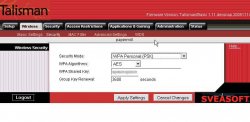Despite basic WEP 40 security, someone is leaching our wireless network at home.
How do I go about protecting it? Using MAC addresses would be fine but I don't know how exactly?
We have one Mac PB, on Windows laptop and one windows desktop.
Also, is there anyway to identify the leach?
Thanks,
AL
Edit: Forgot to say, the router is a D-Link G604T
How do I go about protecting it? Using MAC addresses would be fine but I don't know how exactly?
We have one Mac PB, on Windows laptop and one windows desktop.
Also, is there anyway to identify the leach?
Thanks,
AL
Edit: Forgot to say, the router is a D-Link G604T


